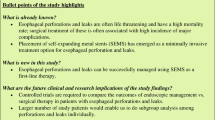Abstract
Background and study aims
Endoscopic suturing reduces stent migration, but is challenging and time-consuming. We compare endoscopic suturing versus anchoring with a novel over-the-scope clip (Padlock) to fix esophageal stents. Additionally, the first clinical case of Padlock stent fixation is reported.
Materials and methods
A fully covered esophageal stent was placed in 11 pigs and fixed with one figure-of-eight suture (n = 5) or with a Padlock (n = 4) or not fixed (controls; n = 2). The force required to mobilize the stent was recorded. Clinical case: an esophageal stent was fixed with a Padlock and endoscopically removed 1 month later, in an 82-year-old patient.
Results
Mean force (newton) to mobilize the stent was similar after suturing and Padlock fixation (23.99 ± 14.91 vs. 19.97 ± 7.62; p = 0.32). In controls was 7 and 11 Newtons. Suturing time (seconds) was longer than Padlock application (455.4 ± 144.83 vs. 155 ± 12.9; p = 0.002). Clinical case: stent fixation was feasible and uncomplicated. Removal was easy, and only mild bleeding occurred.
Conclusions
Padlock is faster than endoscopic suturing and achieves similar stent fixation. The first clinical case confirms the feasibility of the method.





Similar content being viewed by others
References
Choi JH, Lee YJ, Kim ES et al (2013) Covered self-expandable metal stents are more associated with complications in the management of malignant colorectal obstruction. Surg Endosc 27(9):3220–3227
Warden C, Stupart D, Goldberg P (2013) Stenting as first line management for all patients with non-perforating left sided obstructing colorectal cancer. Colorectal Dis 15(7):e389–e395
Vix M, Diana M, Marx L et al (2014) Management of staple line leaks after sleeve gastrectomy in a consecutive series of 378 patients. Surg Laparosc Endosc Percutan Tech
Rieder E, Dunst CM, Martinec DV et al (2012) Endoscopic suture fixation of gastrointestinal stents: proof of biomechanical principles and early clinical experience. Endoscopy 44:1121–1126
Martins BD, Retes FA, Medrado BF et al (2014) Endoscopic management and prevention of migrated esophageal stents. World J Gastrointest Endosc 6:49–54
Kato H, Fukuchi M, Miyazaki T et al (2007) Endoscopic clips prevent self-expandable metallic stent migration. Hepatogastroenterology 54:1388–1390
Vanbiervliet G, Filippi J, Karimdjee BS et al (2012) The role of clips in preventing migration of fully covered metallic esophageal stents: a pilot comparative study. Surg Endosc 26:53–59
Lyons CD, Kim MP, Blackmon SH (2012) A novel fixation procedure to eliminate covered self-expanding metal stent migration. Ann Thorac Surg 94:1748–1750
Moran EA, Gostout CJ, Bingener J (2009) Preliminary performance of a flexible cap and catheter-based endoscopic suturing system. Gastrointest Endosc 69:1375–1383
Kantsevoy SV, Thuluvath PJ (2012) Successful closure of a chronic refractory gastrocutaneous fistula with a new endoscopic suturing device (with video). Gastrointest Endosc 75:688–690
Thompson CC, Chand B, Chen YK et al (2013) Endoscopic suturing for transoral outlet reduction increases weight loss after Roux-en-Y gastric bypass surgery. Gastroenterology 145(129–137):e123
Desilets DJ, Romanelli JR, Earle DB et al (2010) Gastrotomy closure with the lock-it system and the Padlock-G clip: a survival study in a porcine model. J Laparoendosc Adv Surg Tech A 20:671–676
Romanelli JR, Desilets DJ (2010) Earle DB Natural orifice transluminal endoscopic surgery gastrotomy closure in porcine explants with the Padlock-G clip using the Lock-It system. Endoscopy 42:306–310
Acknowledgments
Authors are grateful to Boston Scientific, Apollo Endosurgery and to Aponos Medical for kindly providing the material used in this study. Boston Scientific, Apollo Endosurgery and Aponos Medical had no involvement in data collection or the writing of the manuscript. Furthermore, authors would like to thank Christopher Burel, professional in Medical English proofreading, for his valuable assistance.
Disclosures
Jacques Marescaux is recipient of Grants from Karl Storz, Covidien and Siemens. Lee Swanström has performed consulting services for Aponos Medical. Remaining authors have no conflicts of interest or financial ties to disclose.
Author information
Authors and Affiliations
Corresponding author
Electronic supplementary material
Below is the link to the electronic supplementary material.
Supplementary material 1 (MP4 25741 kb)
Rights and permissions
About this article
Cite this article
Diana, M., Swanström, L.L., Halvax, P. et al. Esophageal covered stent fixation using an endoscopic over-the-scope clip. Mechanical proof of the concept and first clinical experience. Surg Endosc 29, 3367–3372 (2015). https://doi.org/10.1007/s00464-015-4078-0
Received:
Accepted:
Published:
Issue Date:
DOI: https://doi.org/10.1007/s00464-015-4078-0




